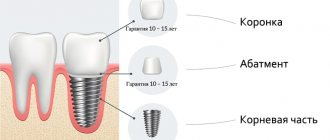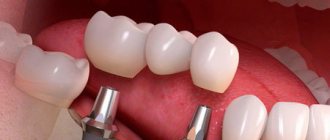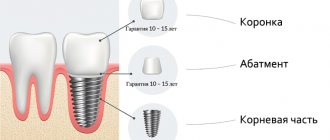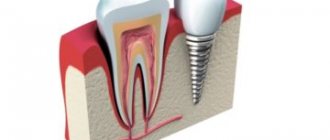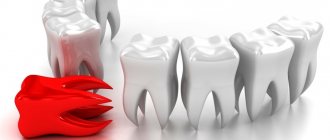Author: Brodsky Sergey Evgenievich Deputy Chief Physician, Candidate of Medical Sciences in the specialties: dentistry and medical microbiology
Implantation is a modern method of restoring teeth. However, it remains an expensive procedure that not every patient resorts to. In addition to cost, there are a significant number of health restrictions, in the presence of which implantation is contraindicated. In this regard, most patients have a question: is there an alternative to dental implants?
On the importance of restoring lost units
Losing teeth causes psychological and physical discomfort. It is especially sad if the front teeth are missing - then you should forget about an open smile.
A person has to learn to smile so that this defect is not visible to others. In addition to the aesthetic problem, there are also difficulties associated with the dining process.
The incisors are used for grasping and biting food. And if there are no incisors, then the person has to contrive and bite off pieces with canines and premolars, which is not very convenient - and, moreover, looks ugly from the outside.
If molars are missing, then serious problems arise with chewing food , because it is the molars that do most of this work.
In addition, the absence of teeth is fraught with the following consequences:
- The amount of bone tissue is reduced. Bone tissue cells are constantly reproducing, and in the absence of external pressure, this process is suspended. The bone decreases in size. If there are many missing teeth, then over time the jaw joints become deformed.
- Problems with the gastrointestinal tract. Pieces of food are not chewed properly and end up in the esophagus almost unchanged. Large pieces injure the lining of the stomach and intestines.
- The contour of the face and the outline of the mouth changes , which may look unattractive.
- The position of the teeth changes. All teeth in the row where there is an “empty space” gradually shift. The opposite row remains without support and the teeth are less able to stay in the socket and may fall out early.
- Pain in the temporal mandibular joint. Painful sensations can be transmitted higher, i.e. Possible migraine.
Important information. To avoid complications, it is better to place the implant immediately after removal. Contraindications to immediate implantation: caries, gum inflammation, lack of bone tissue.
What are endodontically stabilized implants and indications for their use. Come here to take a closer look at combination implant designs.
At this address https://dentist-pro.ru/implantaciya/metodiki/vliyanie-stabilnosti-na-kachestvo.html we will consider ways to determine the primary stability of implants.
Indications for implantation
With the help of implants, you can easily restore the normal functionality of your teeth without putting much strain on the gums themselves. If the roots of a damaged tooth remain in the jaw, dentists can place a crown on them.
In the absence of teeth, implantation makes it possible to restore them so that patients do not feel discomfort with the functionality of the jaw and its appearance. This procedure is suitable for those who want to solve the problem of missing teeth once and for all. A reliable implant can last a long time, but for this, patients should take care of their teeth daily and strictly follow the doctor’s advice.
During the implantation procedure, there is some chance that the gums will become deformed. It is important to note that when choosing traditional prosthetics in the form of removable or fixed dentures, the appearance of the structures deteriorates over time, so they will need to be replaced. If this is not done, the artificial teeth will be visible to other people. That is why implantation is considered the right solution for restoring dentition.
But it is important to take into account all possible contraindications, which in some cases do not allow such a procedure. Then you should pay attention to an alternative to implantation.
Pros and cons of the technique
Implantation is gaining more and more fans, although prosthetics is still considered by many to be a more acceptable option. The implantation technique has its advantages and disadvantages.
The advantages are as follows:
- Implants are durable. The titanium pin completely grows into the bone. Crowns require replacement after 10-12 years.
- When an implant is placed, the adjacent teeth , they do not need to be ground down or filled, and nerve removal is not required.
- The implant performs all functions of capturing and grinding food.
- Easy to care for.
- Aesthetics. The dentist will select the color of the crowns to match the shade of the enamel.
- You can restore a whole series . The doctor does not screw the pins into each hole, but places them at a short distance from each other. The crowns are secured with bridges that will not be visible.
- Hygiene. The lower edges of the crowns cover the gums. Food remains do not fall beyond the edges of the crowns, the likelihood of developing inflammatory processes is excluded.
- Reduced cost. The procedure is becoming more and more accessible.
The operation also has disadvantages:
- Edema may develop.
- Rod rejection. Sometimes the body does not perceive metal. Nicotinic acid can act as an oxidizing agent and negatively affect the engraftment process.
- Risk of damage to the maxillary sinuses. This only applies to the top row.
- Duration of the rehabilitation period.
Useful tips. To avoid these consequences, you must take a responsible approach to choosing a medical institution in which the operation will be performed. It is worth finding out in advance which specialist is best to make an appointment with. An experienced doctor will not damage adjacent tissues. In order not to provoke rejection, you need to give up smoking, at least for a while.
Arguments for installing the device
Are implants good or bad? Despite the fact that the design has disadvantages and disadvantages, there are also advantages and positive aspects. These include:
- Durability and strength of structures. An installed high-quality implant can last more than 10 years.
- If a person has installed such devices, he will not experience discomfort during communication, and chewing function will not be impaired.
- If you install one or more products, there is no need to grind healthy units.
- The devices offered by implantology and dentistry are no different from real teeth.
- No special care is required, traditional hygiene procedures are sufficient.
- When the structures are implanted, a person does not experience the sensation of a foreign object in the mouth, there are no disturbances in taste perception, the process of chewing food is natural and without discomfort.
- There are no restrictions on the number of installed products.
- The implanted device takes on the load of the lost tooth while relieving the load from adjacent units.
- You can quickly eliminate problems of complete edentia.
- Thanks to the procedure, bone loss can be prevented.
- Minimizing changes in the gum margin and subsequent exposure of the crown or prosthesis. Aesthetics are preserved for a long time.
- Crowns or dentures can be firmly fixed, and the implant can withstand increased loads.
- Certain types of products can stimulate bone growth.
- The crown can be replaced if necessary.
- The functioning of the dentition is completely restored.
- Thanks to the large selection of products, you can select and install the most suitable ones for each specific situation.
- High chances of osseointegration.
- Convenient care, which is limited to traditional hygiene procedures.
DETAILS: Bone tissue growth during dental implantation, how gum plastic surgery occurs during dental surgery, how an implant is placed on a bone
Contraindications
There are absolute, temporary, and local contraindications to implantation. Absolute contraindications are a categorical prohibition against performing a surgical operation. The remaining problems are solvable.
The procedure is contraindicated in the following conditions:
- pathologies of the heart and blood vessels (at a severe stage);
- lymphogranulomatosis;
- hemolytic anemia;
- diseases of the central and peripheral nervous systems;
- mental disorders;
- allergy to anesthetics;
- diabetes;
- tuberculosis;
- HIV and AIDS;
- oncology;
- liver and kidney failure.
Relative contraindications include taking medications that can cause rejection. These are immunosuppressants, cytostatic drugs, anticoagulants. The operation should be performed with caution if there are other metal implants in the body.
It is recommended to postpone the procedure if the person has recently suffered a serious illness or has been subjected to severe stress. It is better to wait until the body recovers. Poor nutrition, smoking, and excessive alcohol consumption are also contraindications.
Local are pathologies of the jaw and oral cavity. These include:
- inflammatory processes;
- connective tissue pathologies with localization of inflammation in the jaw and face;
- osteoradionecrosis;
- osteonecrosis of the jaw;
- caries;
- neoplasms in the oral cavity;
- malocclusion;
- bruxism;
- lack of bone tissue.
Temporary contraindications include periods of illness and treatment - in particular, radiation and chemotherapy. Surgery is also contraindicated during pregnancy and while breastfeeding.
Attention! Implantation can only be performed from the age of 22!
Protocol for transosseous implantation and disadvantages of the technique. This publication contains all the most important information about subperiosteal implants.
Here https://dentist-pro.ru/implantaciya/metodiki/bez-kostnoj-plastiki.html we will discuss the pros and cons of implantation without bone grafting.
When are alternative implantation methods used?
Implantation allows you to restore the dentition by implanting metal structures on which the prosthesis is installed. There are many techniques that allow you to restore your smile in a short time - up to 5 days. However, this method is sometimes contraindicated for a certain category of patients who have a history of:
- autoimmune pathologies;
- tendency to allergic reactions;
- oncology and recovery period after a course of chemotherapy;
- dental pathologies in the acute period;
- severe diabetes mellitus;
- AIDS, tuberculosis.
- diseases of the endocrine system;
- acute period of infectious and inflammatory diseases;
- blood clotting disorder.
Implantation is not recommended for patients who neglect oral care.
Heavy smokers should avoid implantation of metal structures, as a bad habit increases the likelihood of implant rejection.
other methods
If the classic implantation procedure is not possible, then the patient is offered alternative methods. These are prosthetics (complete, removable and combined) and reimplantation.
Removable prosthetics
Removable prosthetics are characterized by simplicity and less aggressiveness (compared to other methods). The most popular dentures are clasp, plate and nylon.
In clasp dentures, the basis is a thin solid metal arch made of a durable alloy. It is called a clasp. A base imitating gum is attached to the arch.
Artificial teeth are attached to the base. Fasteners, locks, and crowns are used as fasteners.
This type of prosthetics is recommended if a person is missing 6 or more teeth in a row.
Clasp dentures are durable and reliable, and have a long service life. Caring for them is simple, and the adjustment period takes no more than a week. The prosthesis can be installed on implants. This procedure is also a good prevention of gum disease.
The downside is that the fastening elements can rub the gums and cause discomfort (if the weight of the prosthesis is too large or the arch is installed carelessly).
Clasp dentures cannot be installed if teeth are completely missing. The cost of the product is higher than that of other removable options.
Lamellar removable dentures consist of a base and artificial plastic teeth. The material from which the base is made is nylon, acrylic or polyurethane.
The function of the base is to evenly distribute the load on the gums when chewing food. The design has a silicone insert to give fresh breath.
You can make a prosthesis to order, choose the shade of enamel. Fastening elements - clasps, attachments, suction cups .
The use of plate structures is indicated if teeth are completely missing.
The disadvantage of this method is weak fixation, pain and rubbing when eating if the load is high. But this is a good alternative if a person is allergic to metals.
Nylon dentures have a pinkish base that imitates gum, and an artificial tooth. Nylon is a synthetic polymer material. It is resistant to mechanical stress and therefore suitable for chewing food. It does not cause allergies and does not stain. This is a flexible material that does not break.
Nylon prostheses do not cause discomfort. You can replace either 1 tooth or the entire row.
The downside is the short service life, the impossibility of standard care - with constant contact with hard bristles, the material sags.
In the video, a specialist talks about the types of removable dentures.
Fixed prosthetics
Fixed dentures perform the chewing function better. Materials for manufacturing: ceramics, cermets, metal, zirconium dioxide, plastic.
If partial replacement of teeth is required and it is necessary to preserve the root, then it is better to choose a dental crown.
When making a crown, the specialist’s task is to achieve maximum similarity to the natural sample. After fitting and fitting, the crown is installed on a cement base.
A prerequisite for installing crowns is that the integrity of the root is not compromised . The installation requires preliminary preparation, which is a significant disadvantage if it is placed on a healthy tooth that will be used as a support for the bridge.
A bridge is attached either to adjacent teeth or to an implant. There is a solid cast and stamped version. Stamped ones are held together by soldering. The bridge consists of dental crowns.
If the bridge is metal, then such a design can rub the gums and cause discomfort due to an unpleasant taste in the mouth.
The disadvantage of this technique is that the supporting teeth have to be prepared to secure the bridge.
Combined prosthetics
Combined prosthetics are indicated if removable dentures cannot completely solve the problem, and the patient is against the manufacture of a removable denture.
The most common option is to install a bridge or dental crowns together with a clasp denture.
The clasp is attached to the bridge using locks or clasps. This fixation is very reliable.
Chewing and articulatory function is restored within 30 days after surgery. Diction is not broken. The prosthesis looks aesthetically pleasing.
Reimplantation
Reimplantation is the “reanimation” of a damaged tooth and placing it in its original place as an implant.
The procedure is carried out as follows:
- the surgeon removes the diseased tooth along with the root;
- cleans the hole, treats inflammation;
- at the same time, the dentist cleans, fills and polishes the extracted tooth;
- medicine is placed in the hole;
- Installation is carried out in the same place, a photopolymer thread is used as a retainer.
The risk of rejection is minimized, because This is a “native” implant. Bone tissue is quickly restored. The rehabilitation period lasts up to 3 months (artificial teeth take up to a year).
A prerequisite for the operation is the presence of support on both sides of the operated specimen.
Combined prosthetics
If a patient is diagnosed with periodontal disease, then combined prosthetics becomes an alternative to classical dental implantation. The design consists of a removable and stationary part. A combined denture is much more reliable than a removable one and does not require grinding of teeth, as when installing fixed structures. This type of dental restoration is possible even with the loss of 80% of teeth. A combined prosthesis cannot completely replace implants and in 70% of cases when visiting a dentist, implants are used, but as an alternative method for contraindications to implantation, it has its advantages:
- the strength of the structure itself and the fastenings between the removable and stationary parts. With such a prosthesis there will definitely be no awkward situations with your jaw falling out;
- comfortable to wear and quick to get used to;
- preservation of chewing function without dietary restrictions;
- elimination of speech defects.
Price
Types of implantation differ in cost. Prices are shown in the table below.
| Name of service | Price, rub |
| Tooth extraction and implant installation | From 15000 |
| Installation of dentures on implants in the absence of teeth | From 160000 |
| Bone grafting | From 16000 |
| Installation of 1 implant | From 12000 |
| Single-stage implantation | From 12000 |
| 1 implant | From 22000-48000 |
| Dental crown | From 9000 |
| Tooth impression | From 3000 |
| Plastic removable denture | From 24000 |
| Nylon prosthesis for 1-2 teeth | From 17000 |
| Partial nylon denture | From 26000 |
| Full nylon denture | From 32000 |
| Clasp prosthesis | From 26000 |
| Installation of a temporary crown | From 3000 |
| Solid bridge prosthesis | From 8000 |
| Metal-ceramic bridge prosthesis | From 17000 |
Prices in Moscow clinics are shown here. Prices may be lower in other cities. The average cost of implantation ranges from 6,000 to 70,000, depending on the type of operation, the volume and complexity of the work, and the material from which the implant is made.
How much does it cost to get a dental implant?
Naturally, people who decide to get a dental implant are interested in the cost of this service in Moscow. But it is impossible to give an exact answer to the question of how much it costs to place a dental implant in Moscow in absentia.
First you need to decide on the following points:
- Do you need bone grafting to place implants? The price of bone grafting seriously affects the cost of implantation;
- What type of bone grafting will be used to place implants. The price of implantation also depends on the type of osteoplasty and the materials used in it;
- Are dental treatment/extraction procedures required before placing an implant;
- Is oral sanitation necessary before placing an implant?
- What technology will be chosen to place the implant;
- Which implant do you decide to place;
- How many implants do you need to get;
- How you decide to place the implant - using navigational implantation, under local anesthesia or sedation.
Having decided on these points, you can calculate how much it will cost to place 1 dental implant in Moscow. When calculating the price for which you can install an implant, do not forget about the cost of permanent prosthetics: it is usually not included in turnkey implantation and is calculated separately. Do you want to know the exact price you will have to pay to get a dental implant? Contact us - premium dentistry in Moscow - Firadent! Place an implant with us - get a beautiful smile quickly and without pain, without the risk of complications and with a quality guarantee!
Bioteeth: growing teeth
Thanks to new developments by bioengineers in dentistry, technologies may appear in the near future that will make it possible to abandon implantation and the traditional methods of prosthetics currently used. We are talking about growing new teeth or regenerating damaged ones using bioconstructive material, which includes a person’s own gum cells, supporting material, signaling molecules and stem cells.
Scientists are conducting experiments to create tooth germs in the form of a bunch of cells, which can then be transplanted into the human jaw. Over time, this clot will develop into a full-fledged tooth with a root, pulp and crown. The main task of specialists, the implementation of which can bring the cultivation of bioteeth into clinical practice, is the search for cells suitable for the production of rudiments and capable of developing normally in the body of an adult.
According to scientists' forecasts, a new prosthetic technique based on growing bioteeth may partially enter into practice closer to the second half of the 21st century.
Share the article on social media. networks:
Rules of care
If dental implantation is performed, the service life of the structure also depends on compliance with all rules of care in the postoperative period. During the first 14 days after surgery, you should eat only soft foods. Food should be liquid or puree. It is necessary to include a large amount of vitamins and minerals in the diet. The first few days you need to chew on the other side.
Clean your teeth very carefully so as not to touch or damage the implant. Experts recommend rinsing your mouth after eating with special solutions or herbal decoctions. The implant itself is located inside the gum and does not require special cleaning. Care is carried out only for crowns or dentures.
The gums under the denture are cleaned using a soft-bristled toothbrush. After eating, it is recommended to cleanse with floss or use special solutions. It is imperative to contact your dentist if any problems or defects are discovered. Due to the heavy load on the product, it is not recommended to eat too hard foods – nuts, crackers. Get a dental check-up every six months. Have your dentures professionally cleaned.
- Why may problems arise after dental implantation?
- Contraindications for dental implantation
- How long does a dental implant last and how long does it take to replace it?
- How soon can you eat after dental implantation?
Advantages and disadvantages
It is not for nothing that implantation in dentistry has gained a leading position among all existing prosthetic methods. Both doctors and patients highlight the following advantages of this procedure:
- root implantation and crown installation do not affect adjacent units and do not require grinding, leaving healthy teeth intact;
- by maintaining the functional load on the bone tissue, it is possible to completely stop the atrophic process;
- the durability of the design is guaranteed by the manufacturer, and it depends only on the patient’s actions whether the product will have to be replaced with a new one;
- implants can withstand the full load during chewing, talking and other normal movements in daily life, and it is distributed evenly throughout the jaw;
- strength of fastening of the structure in the bone;
- helps to avoid displacement of the dentition and curvature of neighboring units;
- after the final stage of recovery, the patient has no discomfort in the mouth, the artificial material is perceived by the body as natural;
- due to the high quality of the components used to create the implant, the risks of rejection are significantly reduced;
- good aesthetics of the smile, teeth look like your own natural ones;
- it is possible to replace one element, several or even a whole series;
- due to the existence of different designs, implantation technologies and the range of available products, you can select the appropriate option in each specific case;
- practicality lies in the fact that such prostheses do not require special additional care, as is the case with removable plates; it is enough to follow the usual rules of hygiene.
But before agreeing to implantation, you have to undergo a series of examinations. The doctor carefully examines the oral cavity, the condition of hard and soft tissues, and selects the optimal product option for the patient. And it is important that the specialist warns the person about the existing disadvantages of implantation:
- healing and the procedure will be extended over time, it will take more than one month;
- immediately after the operation, painful sensations appear, and the wound requires careful care;
- high prices for the products themselves and the doctor’s work, as well as preparatory manipulations make implantation not accessible to everyone;
- there are a huge number of contraindications to the procedure that cannot be ignored;
- After implantation of the rod, various complications may occur.
To decide whether you personally need such an operation, you should carefully weigh the pros and cons of implantation and take into account individual characteristics.

